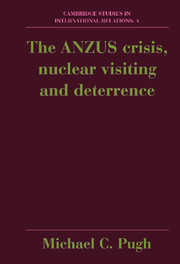Book contents
- Frontmatter
- Contents
- List of tables
- Preface
- List of abbreviations
- 1 INTRODUCTION: THE REVOLT OF AN UNDERLING
- 2 THE ANZUS TREATY AND STRATEGIC DEVELOPMENTS
- 3 DEFENCE CO-OPERATION AND NUCLEAR CONNECTIONS
- 4 WARSHIP ACCESS AND THE ANZAC LIABILITY SUSPENSIONS
- 5 NUCLEAR HAZARDS AND ENVIRONMENTAL SAFETY: ISSUES OF THE 1980S
- 6 ANTI-NUCLEAR POLITICS
- 7 FROM NEGOTIATION TO LEGISLATION
- 8 REGIONAL SECURITY AND THE FUTURE OF ANZUS
- 9 THE ANZUS CRISIS, NUCLEAR VISITING AND THE WESTERN ALLIANCE
- APPENDICES
- Notes
- Bibliography
- Index
5 - NUCLEAR HAZARDS AND ENVIRONMENTAL SAFETY: ISSUES OF THE 1980S
Published online by Cambridge University Press: 06 July 2010
- Frontmatter
- Contents
- List of tables
- Preface
- List of abbreviations
- 1 INTRODUCTION: THE REVOLT OF AN UNDERLING
- 2 THE ANZUS TREATY AND STRATEGIC DEVELOPMENTS
- 3 DEFENCE CO-OPERATION AND NUCLEAR CONNECTIONS
- 4 WARSHIP ACCESS AND THE ANZAC LIABILITY SUSPENSIONS
- 5 NUCLEAR HAZARDS AND ENVIRONMENTAL SAFETY: ISSUES OF THE 1980S
- 6 ANTI-NUCLEAR POLITICS
- 7 FROM NEGOTIATION TO LEGISLATION
- 8 REGIONAL SECURITY AND THE FUTURE OF ANZUS
- 9 THE ANZUS CRISIS, NUCLEAR VISITING AND THE WESTERN ALLIANCE
- APPENDICES
- Notes
- Bibliography
- Index
Summary
Whereas the liability suspensions had been largely a matter of concern to bureaucrats, naval officers and insurance brokers, the rein statement of nuclear-powered visits to Australia and New Zealand in 1976 activated a wider interest in naval visiting. Although the assurance of legal indemnity satisfied governments, it did little to calm public fears of reactor or weapon accidents in ports. Indeed the development of the US Navy's nuclear reactor programme, together with the dispersion of nuclear missiles, fostered concern among environmentalists as well as traditional nuclear disarmers. The risk of mishap had allegedly increased.
The current deployment of nuclear missiles in the USN was discussed in chapter 1. It should be recalled that over 80 per cent of the major combatants were categorized as nuclear capable. For convenience table 5.1 provides a summary of nuclear-powered, as well as nuclear-capable, vessels.
This chapter therefore examines controversies which affected the management of visits. Under pressure from port authorities, environmentalists and anti-nuclear groups, politicians and officials on both sides of the Tasman reconsidered the safety assessments which had underpinned the procedures and principles of 1976. The New Zealand Select Committee on Disarmament and Arms Control received submissions on the issue in 1983 and the Atomic Energy Committee began a review of its code in 1984. In Australia, serious practical issues of managing ship visits became apparent, and at the end of 1986 an Australian Senate committee commenced deliberations on accident contingencies and safety regulations.
- Type
- Chapter
- Information
- The ANZUS Crisis, Nuclear Visiting and Deterrence , pp. 82 - 99Publisher: Cambridge University PressPrint publication year: 1989



